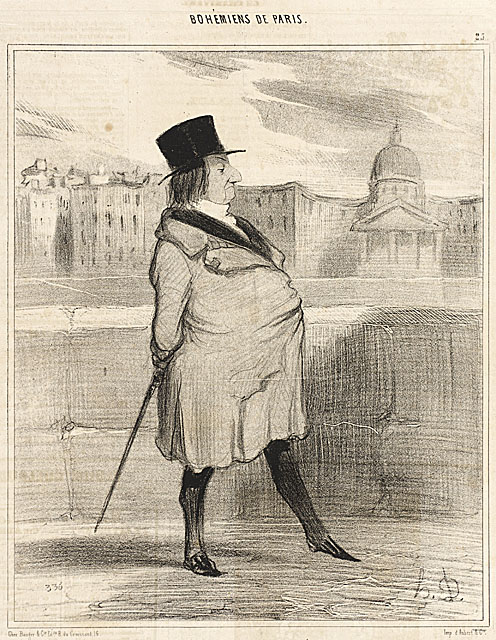
Honoré Daumier Le Membre de toutes les Académies [Member of All the Academies] 1842 lithograph 9.5" x 7.75" (sheet)
We're "Art Moralists", according to the headline above Jerry Saltz's second New York magazine "Intelligencer" piece. That headline reflects the attitude of some in the art world who have commented on the objections being raised to the New Museum's intention to fill its galleries with a show of a part of Dakis Joannou's collection curated by Jeff Koons, but others are wondering what the critics of that plan have against the museum, the collector, the curator, or perhaps even the art itself.
While it's refreshing to see an American use a form of the word "morals" and not be complaining about unorthodox sexuality, it's hugely disappointing to see an art critic whom I've long respected, and continue to respect, almost casually dismiss the genuine issues of institutional ethics (which have been raised since September 25th) without bothering to understand them or refute them with a judicious argument.
Saltz isn't the only commentator who has failed to recognize the merits of the arguments of the people whom he describes as having "harped" on the ethics of the NuMu/Joannou deal, but at least he doesn't question their integrity. I've seen a number of writers do just that, having failed to see the problem. They're questioning the motives of what one source refers to as the "morality police", asking what kind of grudge the critics of the arrangement might have against the principals involved.
I have complete confidence in the integrity of my original argument, and it's pretty much the same argument outlined by William Powhida, picked up elsewhere, and still being pursued today all over the art world. While I cannot look into the souls of other writers and commenters I have no reason to believe their arguments are based on grudges any more than my own: I have always been enthusiastic about the concept and, usually, the reality, of the New Museum; I have to confess to having an almost total ignorance of the details of the current NuMu administration until this issue appeared; I've found Massimilliano Gioni's curatorial input interesting and worthy of attention; and I've never made fun of Jeff Koons's work or doubted its virtues or those of the artist.
The merits of the argument are genuine. I don't doubt that they can be intelligently disputed, but only if they are understood and if hysterics can be avoided on all sides. Regardless of where the reader stands on the issue now, a calmly-reasoned Bloggy post, published November 12, is a useful reference. It succeeds in moving the entire discussion into a much larger framework. It's well worth sharing with anyone interested in the arts in America, so I've re-blogged it below. [full disclosure: Bloggy is the personal site of my partner, Barry]
Bloggy:
Museums, the art market, and public subsidies
A set of scattered thoughts on the New Museum's plans to show works from Dakis Joannou's collection selected by Jeff Koons.
- Many people have argued online via blog posts or comments that the collection is so interesting that it doesn't matter what the ethics are in presenting it at the museum where Mr. Jouannou is a trustee.
- I for one don't want to see some of the limited resources and spaces available to show art in this city devoted to a huge exhibition mostly composed of previously-market-validated living artists that we have all heard of already.
- The New Museum and other museums receive public funding, to say nothing of the subsidies represented by the tax exemption of donations of art and money. The 990 for the New Museum for 2008 shows over $940,000 coming from government grants.
- Because public funding is still a relatively small percentage of their operating budgets, museums and other non-profit cultural spaces must raise money from wealthy patrons, foundations, and other sources (which are subsidized through tax deductions or the non-profit status of foundations).
- This is a country that has trouble convincing taxpayers that guaranteeing decent education and healthcare for all American children is something government should do. If that is considered a luxury in the USA, the use of tax-exempt art museums to show works (owned by wealthy collectors) by artists who have been successful in the commercial art market is a rather decadent use of public subsidies.
- If the market is how we decide what works of art are important, then the market should find a way to cover the costs of presenting these works to the public. The curatorial, educational or scholarly mission of museums is tossed aside, and thus the rationale for providing subsidies, other than the tourism draw of such institutions, disappears.
- Abandoning the assistance that non-profit institutions have provided to emerging artists, unknown artists, and artists whose work is not successful in the commercial art market will further undermine public support for any kind of funding for culture, which is already pretty shaky.
[image from Lacma Collections]
Hear, hear!
James and Barry,
You guys have done great work on this issue, been out there ahead of the curve. Thanks for the continued work in following the twists and turns of this complex story. (I'll no doubt be seeing you at the next cocktail reception at the NuMu.)